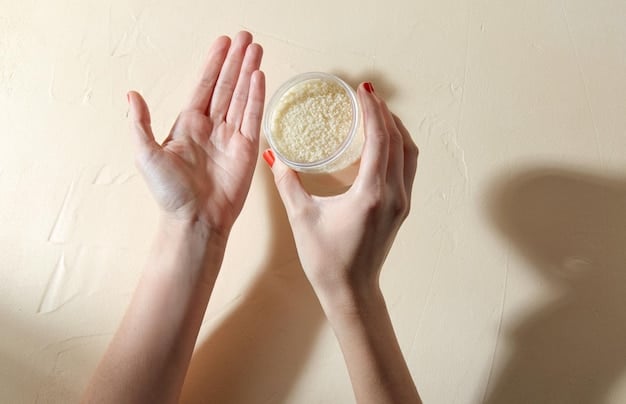Dry Skin SOS: 7 Hydrating Ingredients Dermatologists Recommend for Winter 2025

Anúncios
Dermatologists consistently recommend specific hydrating ingredients like hyaluronic acid, ceramides, glycerin, and urea to combat dry winter skin in 2025 by bolstering the skin’s natural barrier and attracting moisture from the environment.
As winter’s chill descends, so often does the relentless challenge of dry, parched skin. The dropping temperatures and harsh winds conspire to strip away our skin’s natural moisture, leaving it feeling tight, flaky, and uncomfortable. But fear not, for the world of dermatology offers a beacon of hope. This comprehensive guide, “Dry Skin SOS: 7 Hydrating Ingredients Dermatologists Recommend for Winter 2025,” delves into the most effective, scientifically-backed ingredients poised to be the heroes of your winter skincare routine. We’ll explore why these components are essential, how they work their magic, and what to look for when integrating them into your regimen.
Anúncios
Understanding winter’s assault on your skin
Winter brings with it a unique set of challenges for skin health. Beyond the obvious drop in temperature, several environmental factors contribute to increased dryness and irritation during these colder months. Understanding these mechanisms is the first step towards an effective defense strategy for 2025 and beyond.
The culprits: low humidity and harsh winds
The primary antagonist in winter skin dryness is the significant drop in ambient humidity. Cold air simply cannot hold as much moisture as warm air. This means that indoors, heating systems further deplete the air of moisture, creating an arid environment that actively pulls water from your skin. Outdoors, icy winds act like a natural scrubber, stripping away the skin’s protective lipid barrier and accelerating moisture loss. This constant depletion leads to a compromised skin barrier, making skin more susceptible to irritation, redness, and the formation of microscopic cracks.
The stratum corneum: your skin’s first line of defense
At the outermost layer of your skin lies the stratum corneum, often described as a “brick and mortar” structure. The “bricks” are corneocytes (dead skin cells), and the “mortar” is composed of lipids like ceramides, cholesterol, and fatty acids. This intricate structure is crucial for maintaining skin integrity, preventing excessive water loss (transepidermal water loss, or TEWL), and blocking the entry of irritants. In winter, this barrier becomes weakened, leading to the familiar symptoms of dry skin. A healthy, intact stratum corneum is paramount for hydrated, resilient skin.
Anúncios
As we navigate the colder months, the goal is not just to add moisture but to rebuild and protect this vital barrier. This involves a multi-pronged approach that includes gentle cleansing, strategic layering of hydrating products, and consistent application. The ingredients we will discuss are specifically chosen for their ability to support this fundamental aspect of skin health, ensuring your skin remains supple and strong even when faced with the harshest winter conditions. Hydration is not merely about comfort; it’s about preserving skin function and overall well-being.
Hyaluronic acid: the ultimate moisture magnet
Hyaluronic acid (HA) has long been celebrated as a powerhouse in hydration, and for good reason. Its unique ability to attract and hold vast amounts of water makes it an indispensable ingredient for anyone battling dry winter skin. This humectant naturally occurs in our skin, joints, and eyes, playing a crucial role in maintaining moisture and elasticity.
How hyaluronic acid works its magic
HA is a powerful humectant, meaning it draws moisture from the environment and binds it to the skin. A single molecule of hyaluronic acid can hold up to 1,000 times its weight in water, effectively plumping the skin and reducing the appearance of fine lines caused by dehydration. During winter, when humidity levels are low, HA becomes even more critical. It acts like a sponge, pulling available moisture from the air and from deeper layers of the skin, locking it into the epidermis.
Different forms for different benefits
The world of hyaluronic acid is more nuanced than it might appear. Not all HA is created equal. Different molecular weights of HA offer distinct benefits:
- High molecular weight HA: Forms a hydrating film on the skin’s surface, preventing moisture loss and providing immediate hydration. This is excellent for surface-level plumping.
- Low molecular weight HA: Can penetrate deeper into the skin due to its smaller size, offering more profound and long-lasting hydration. This helps to improve skin elasticity and reduce the appearance of fine lines from within.
- Sodium hyaluronate: A salt form of HA, known for its smaller molecular size and better stability, allowing it to penetrate the skin more effectively.
Dermatologists often recommend products that contain a mix of these molecular weights to provide comprehensive hydration across all layers of the epidermis. When selecting a product, look for formulations that proudly mention diverse HA types, ensuring you get the most out of this incredibly versatile ingredient. Consistency in use is key to seeing cumulative benefits, particularly in the unforgiving winter months.

Ceramides: rebuilding the skin’s protective barrier
Ceramides are often hailed as the cornerstone of a healthy skin barrier, and their importance cannot be overstated, especially during the drying winter months. These lipid molecules are naturally found in high concentrations within the stratum corneum, forming the “mortar” that holds our skin cells together.
The vital role of ceramides in skin health
Think of your skin barrier as a protective wall. Ceramides are the essential building blocks that keep this wall strong and intact. They comprise about 50% of the lipids in the stratum corneum, working in tandem with cholesterol and fatty acids to prevent transepidermal water loss (TEWL) and protect against environmental aggressors, irritants, and allergens. When ceramide levels are low—a common occurrence in dry skin conditions like eczema or simply due to harsh weather—the skin barrier becomes compromised, leading to increased moisture loss, inflammation, and sensitivity.
Why winter demands ceramide-rich skincare
During winter, the harsh environmental conditions actively deplete the skin’s natural ceramide reserves. This depletion exacerbates dryness, flakiness, and discomfort. Incorporating ceramide-rich products into your skincare routine effectively replenishes these vital lipids, helping to:
- Strengthen the skin barrier.
- Reduce water loss and seal in moisture.
- Calm irritation and redness.
- Improve skin texture and resilience.
Dermatologists frequently recommend ceramides not just for their direct hydrating effects but for their reconstructive capabilities. They are crucial for restoring the skin’s natural defense mechanism, making the skin more resistant to the drying effects of cold air and indoor heating. Regular use of ceramide-infused moisturizers can transform severely dry, compromised skin into a supple, protected state, offering a robust shield against the winter elements. Look for products containing “ceramide NP,” “ceramide AP,” or “ceramide EOP” for broad-spectrum barrier support.
Glycerin: a time-tested hydrating hero
Glycerin, also known as glycerol, is a simple yet incredibly effective humectant that has been a staple in skincare for decades. Its efficacy and excellent safety profile make it a go-to ingredient for dermatologists recommending solutions for dry skin, especially during the harsh winter conditions.
Glycerin’s unique mechanism of action
Like hyaluronic acid, glycerin is a humectant. It functions by attracting water from the air and drawing it into the outer layer of the skin, the epidermis. What makes glycerin particularly noteworthy is its ability to not only hydrate but also strengthen the skin’s natural barrier function. It works by creating a protective layer that helps to prevent moisture loss, locking in the hydration it has drawn. This dual action of attracting and retaining moisture makes it highly effective in combating dryness.
The benefits of glycerin for winter skin
In winter, when the environment is dry, and the skin is prone to cracking and irritation, glycerin steps in as a vital ally. Its benefits extend beyond simple hydration:
- Enhanced barrier function: Glycerin helps to organize lipids in the stratum corneum, improving the skin’s ability to defend itself.
- Improved elasticity: By keeping the skin well-hydrated, glycerin contributes to a more supple and less prone-to-cracking texture.
- Soothing properties: It can help to alleviate irritation and redness often associated with excessively dry skin, providing a sense of comfort.
Dermatologists often recommend products with glycerin because it’s non-comedogenic (won’t clog pores), suitable for all skin types, including sensitive and acne-prone skin, and rarely causes irritation. It serves as an excellent foundational hydrator that works synergistically with other ingredients to provide comprehensive relief from winter dryness. Look for it listed high up in the ingredient list of your moisturizers, cleansers, and serums for maximum benefit.
Urea: a powerful, multi-functional moisturizer
Urea is a remarkably versatile ingredient, highly regarded by dermatologists for its exceptional hydrating, exfoliating, and barrier-repairing properties. While it might not have the same buzz as hyaluronic acid or ceramides, its effectiveness in treating persistent dryness and specific skin conditions makes it indispensable, particularly in the winter.
Beyond hydration: urea’s unique triple action
Urea is naturally found in healthy skin as part of the Natural Moisturizing Factor (NMF), where it plays a critical role in maintaining hydration. When applied topically, it offers a triple-threat approach to dry skin:
- Humectant: Like glycerin, urea attracts and holds water, drawing moisture into the skin to instantly alleviate dryness.
- Keratolytic: At higher concentrations (typically above 10%), urea gently breaks down the bonds between dead skin cells, promoting gentle exfoliation. This helps to shed flaky skin and allows other hydrating ingredients to penetrate more effectively.
- Emollient & Barrier Repair: Urea helps to improve the skin’s barrier function by influencing lipid synthesis and organization. It also makes the skin feel softer and smoother.
This multi-functional capability makes urea particularly effective for conditions characterized by extreme dryness, scaling, and thickening of the skin, such as eczema, psoriasis, and ichthyosis, which can be aggravated by winter weather.
Integrating urea into your winter routine
Dermatologists often recommend urea for its ability to address both the symptoms and underlying causes of dry skin. Products with different concentrations of urea are available:
- Low concentrations (2-10%): Ideal for daily hydration and maintaining skin softness, perfect for regular winter use on the face and body.
- Higher concentrations (10-40%): Used to treat thick, rough skin on areas like heels, elbows, and knees, providing significant keratolytic effects.
Consider starting with a lower concentration to see how your skin reacts, especially if you have sensitive skin. Urea’s ability to hydrate, gently exfoliate, and support the skin barrier makes it an excellent choice for a robust winter skincare regimen, ensuring skin remains soft, smooth, and healthy from head to toe.
Petrolatum and mineral oil: proven occlusives
Often misunderstood and sometimes unfairly maligned, petrolatum (petroleum jelly) and mineral oil are two of the most effective occlusive agents available in skincare. Dermatologists routinely recommend these ingredients for severe dryness, especially in the harsh realities of winter. Their primary function is not to add moisture directly, but to prevent its loss.
The power of occlusion: sealing in moisture
Petrolatum and mineral oil work by forming a protective, non-permeable barrier on the skin’s surface. This barrier effectively seals in existing moisture, dramatically reducing transepidermal water loss (TEWL). When the air is dry and strips moisture from the skin, these occlusives act as a physical shield, keeping your skin’s natural hydration locked in.
- Petrolatum: Recognized as one of the most effective occlusives, it can reduce TEWL by over 98%.
- Mineral Oil: A highly refined, non-comedogenic oil that is also an excellent occlusive, though slightly less potent than petrolatum.
Neither ingredient is inherently moisturizing in the sense of adding water to the skin. Instead, they act like a waterproof blanket, preventing the evaporation of water that is already there or that has been applied with a humectant.
Dispelling myths and maximizing benefits
Despite common misconceptions, highly refined petrolatum and mineral oil are non-comedogenic (meaning they won’t clog pores for most people) and hypoallergenic. They are excellent choices for sensitive, irritated, and very dry skin due to their inertness, meaning they are less likely to cause allergic reactions or irritation than many other ingredients.
Dermatologists often advise applying a humectant (like hyaluronic acid or glycerin serum) first, allowing it to penetrate, and then layering an occlusive like petrolatum or a rich moisturizer containing mineral oil on top. This “seal it in” strategy is particularly effective overnight or during periods of extreme cold exposure in winter. For very dry patches, cracked heels, or chapped lips, these ingredients provide unparalleled protection and healing. Embrace these time-tested ingredients as crucial components of your dry skin SOS kit for winter 2025.
Squalane: the lightweight, skin-identical emollient
Squalane, a hydrogenated and stable form of squalene, has gained significant traction in the skincare world, and for good reason. It’s a natural lipid that our skin produces, making it an incredibly skin-friendly and effective emollient, especially beneficial for winter dryness without feeling heavy or greasy.
Nature’s own moisturizer: squalane’s origins and benefits
Our skin naturally produces squalene, a lipid that is a vital component of sebum and the skin’s natural moisture barrier. However, squalene is unstable and oxidizes easily when exposed to air. Squalane is created by hydrogenating squalene, making it stable, non-comedogenic, and highly resistant to oxidation. This process transforms it into a lightweight yet deeply moisturizing oil.
As an emollient, squalane works by filling in the gaps between skin cells, smoothing the skin’s surface, and reinforcing the lipid barrier. This helps to reduce further moisture loss, making the skin feel soft, supple, and less prone to irritation. Its skin-identical nature means it is readily recognized and utilized by the skin, leading to excellent absorption without a heavy residue.
Why squalane is ideal for winter conditions
In winter, when many people hesitate to use thick, heavy creams, squalane offers a brilliant alternative. It provides substantial hydration and barrier support but with a remarkably lightweight feel. This makes it particularly suitable for:
- All skin types: Even oily or acne-prone skin types that still experience winter dryness can benefit from squalane without fear of breakouts.
- Layering: Its light texture allows it to be easily layered under other products and makeup, integrating seamlessly into any routine.
- Sensitive skin: Being non-irritating and hypoallergenic, it’s an excellent choice for compromised or sensitive skin.
Dermatologists appreciate squalane for its biomimetic properties – it mimics the skin’s natural oils, helping to balance oil production while delivering essential moisture. Incorporating a squalane-rich serum or moisturizer can significantly improve skin comfort and resilience during the colder months, leaving your complexion feeling nourished and protected without occlusive heaviness.
Oats (colloidal oatmeal): soothing and strengthening
Colloidal oatmeal might sound like a simple, traditional remedy, but its power in skincare is scientifically backed and dermatologically celebrated. For dry, itchy, and irritated winter skin, it acts as a gentle yet potent balm, offering both immediate relief and long-term barrier support.
The multifaceted benefits of colloidal oatmeal
Colloidal oatmeal is finely ground oat grain, which, when dispersed in water, creates a protective film on the skin. Its therapeutic properties stem from a unique composition of beneficial compounds:
- Beta-glucans: These polysaccharides attract and hold moisture, providing superior hydration.
- Avenanthramides: Powerful antioxidants and anti-inflammatory compounds that soothe irritation, redness, and itching, which are common in dry and compromised skin.
- Lipids and proteins: These help to reinforce the skin’s natural barrier, preventing further moisture loss.
The combined action of these components makes colloidal oatmeal an excellent ingredient for calming various skin concerns, from simple dryness to more complex conditions like eczema and psoriasis, which often flare up in winter.
Why oats are a winter skincare essential
During winter, skin is frequently exposed to environmental stressors that can trigger inflammation and significant moisture loss. Colloidal oatmeal directly addresses these challenges by:
- Reducing itch and irritation: Its anti-inflammatory properties quickly alleviate discomfort, making it a godsend for intensely itchy dry skin.
- Forming a protective barrier: It creates a physical barrier that helps to seal in moisture and protect the skin from further environmental damage.
- Supporting the microbiome: Some studies suggest that the prebiotics in oats can help support a healthy skin microbiome, contributing to overall skin health.
Dermatologists often recommend colloidal oatmeal in cleansers, lotions, and creams for sensitive, dry, and irritated skin. Its soothing nature makes it safe for daily use, even on the most delicate skin. Integrating products with colloidal oatmeal can significantly enhance comfort and recovery for skin that’s struggling against the winter elements, providing a gentle yet formidable defense against dryness and inflammation.

Beyond ingredients: holistic winter skin care tips
While incorporating the right hydrating ingredients is paramount, a truly effective winter skincare regimen extends beyond just product selection. A holistic approach that addresses daily habits and environmental factors can make a significant difference in maintaining healthy, comfortable skin throughout the colder months.
Optimizing your environment for skin health
The air indoors can be just as drying as the outdoor elements. Heating systems drastically reduce humidity, creating an arid environment that saps moisture from your skin. To counteract this:
- Use a humidifier: Placing a humidifier in your bedroom or frequently used living spaces can significantly increase indoor humidity, providing much-needed moisture to your skin.
- Lower thermostat settings: Slightly reducing your indoor heating can prevent excessive drying of the air and your skin.
- Avoid prolonged hot showers: While tempting, hot showers strip natural oils from the skin. Opt for lukewarm water and keep showers brief.
These seemingly small adjustments to your home environment can have a profound impact on preventing skin dryness and irritation before it even begins.
Lifestyle adjustments for resilient winter skin
Your daily habits play a crucial role in your skin’s ability to withstand winter’s assault. Consider these lifestyle tips:
- Stay hydrated internally: Drink plenty of water throughout the day. While direct studies on water intake’s impact on skin hydration are mixed, overall body hydration is vital for skin health.
- Gentle cleansing: Use a mild, hydrating cleanser that doesn’t strip your skin of its natural oils. Avoid harsh soaps or foaming cleansers.
- Moisturize immediately after washing: Applying moisturizer to damp skin helps to seal in moisture, maximizing its effectiveness.
- Protect yourself outdoors: Wear scarves, hats, and gloves to shield your skin from cold winds and temperatures.
By combining these environmental and lifestyle adjustments with a targeted skincare routine featuring dermatologically recommended ingredients, you’ll be well-equipped to face winter 2025 with hydrated, comfortable, and resilient skin. Remember, consistency and attention to detail are your best allies in the fight against winter dryness.
| Key Ingredient | Primary Benefit for Dry Skin |
|---|---|
| 💧 Hyaluronic Acid | Attracts and holds up to 1000x its weight in water, plumping skin. |
| 🛡️ Ceramides | Rebuilds and strengthens the skin’s protective barrier, preventing water loss. |
| 🧴 Glycerin | Draws moisture into skin and reinforces barrier, providing lasting hydration. |
| 🌿 Colloidal Oatmeal | Soothes irritation, reduces itching, and reinforces the skin’s protective barrier. |
Frequently Asked Questions About Winter Skincare
Winter air has lower humidity, both indoors (due to heating systems) and outdoors. This arid environment actively draws moisture from your skin, leading to increased transepidermal water loss and a compromised skin barrier, resulting in dryness, flakiness, and irritation. Cold winds further exacerbate this effect by stripping away protective lipids.
Yes, but with a crucial caveat. Hyaluronic acid is a humectant, meaning it draws moisture. In very dry environments, it might draw moisture from deeper skin layers. To prevent this, always apply a humectant like HA to damp skin, then follow immediately with an occlusive moisturizer (like one containing ceramides or petrolatum) to seal that moisture in and prevent evaporation.
A general rule is thinnest to thickest consistency. Start with a hydrating cleanser, followed by a serum (e.g., hyaluronic acid), then a richer moisturizer or cream containing ingredients like ceramides, glycerin, or squalane. For very dry skin, a final occlusive layer like petrolatum can be applied to seal everything in, particularly before bed.
Yes, many natural oils can be beneficial. Oils like squalane, jojoba, argan, and rosehip are excellent emollients that help reinforce the skin barrier and reduce moisture loss. However, not all oils are equal; some, like coconut oil, can be comedogenic for certain skin types. Always test new oils gradually and ensure they are high-quality, pure versions.
Absolutely. Many cleansers, especially foaming or harsh ones, can strip your skin’s natural oils, exacerbating winter dryness. Switch to a mild, hydrating, cream-based, or oil-based cleanser that helps maintain your skin’s barrier function. Look for cleansers that are labeled “fragrance-free” and “for dry or sensitive skin.”
Conclusion
Navigating the challenges of dry winter skin in 2025 doesn’t have to be a losing battle. By understanding the science behind skin hydration and strategically incorporating dermatologically recommended ingredients, you can transform your complexion from parched and irritated to comfortably hydrated and resilient. From the moisture-attracting prowess of hyaluronic acid and glycerin to the barrier-repairing capabilities of ceramides and urea, and the protective shields offered by petrolatum and squalane, each ingredient plays a vital role. Remember that a holistic approach, encompassing environmental adjustments and gentle daily habits, will amplify the effectiveness of your chosen products, ensuring your skin remains healthy and glowing through even the harshest winter conditions.





